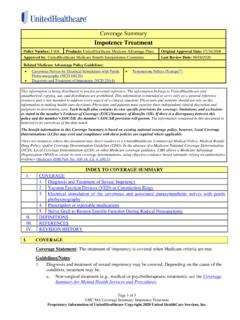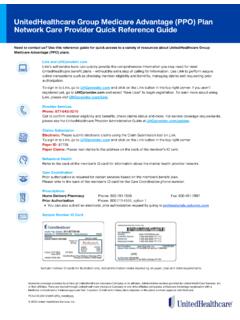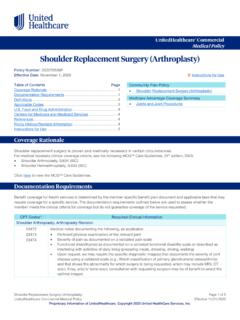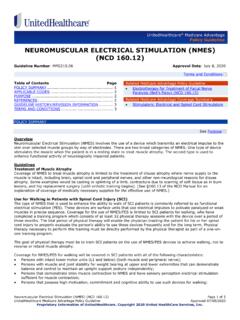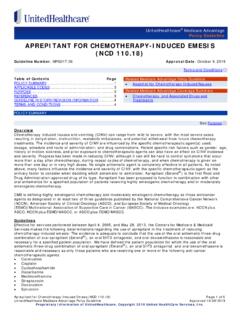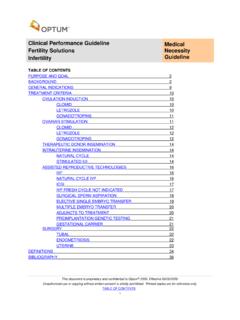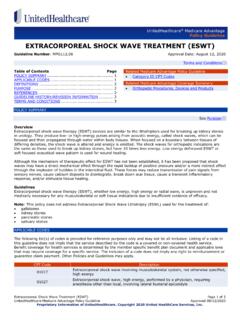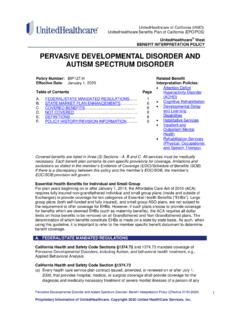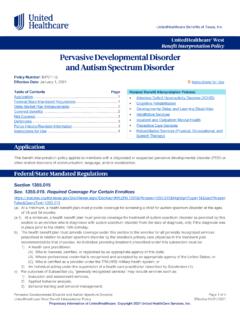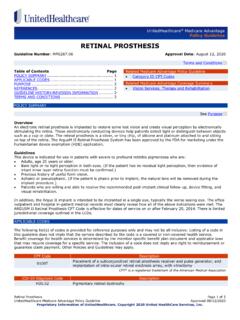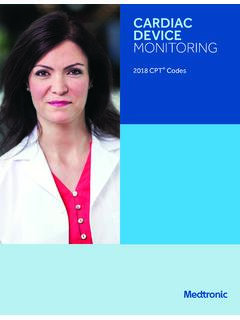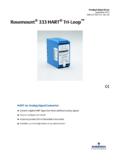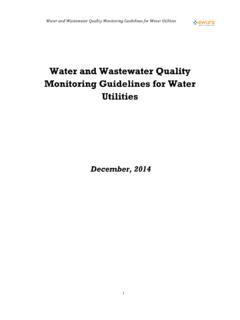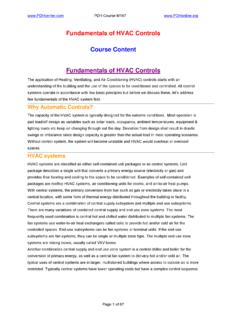Transcription of Long-Term Wearable Electrocardiographic Monitoring
1 UnitedHealthcare Medicare Advantage Policy Guideline Long-Term Wearable Electrocardiographic Monitoring Guideline Number: Approval Date: November 10, 2021 terms and Conditions Table of Contents Page Related Medicare Advantage Policy Guideline Policy Summary .. 1 Electrocardiographic Services (NCD ). Applicable Codes .. 3. Definitions .. 26 Related Medicare Advantage Reimbursement Policy References .. 26 Time Span Codes Policy, Professional Guideline History/Revision Information .. 27 Related Medicare Advantage Coverage Summary Purpose .. 28. Cardiovascular Diagnostic and Therapeutic terms and Conditions .. 28. Procedures Policy Summary See Purpose Overview Long-Term Wearable Electrocardiographic Monitoring is a diagnostic procedure that provides a record of the heart rhythm during daily activities, including sleep. This procedure can often identify the existence and determine the frequency of clinically significant rhythm disturbances and waveform abnormalities that are missed on a standard electrocardiogram (ECG).
2 Guidelines Non-Activated Continuous Recorders (Holter Monitor/External Electrocardiographic Recording). Indications for external 48-hour ECG recording include one or more of the following: Symptoms: o Arrhythmias o Chest pain o Syncope (lightheadedness) or near syncope o Vertigo (dizziness). o Palpitations o Transient ischemic episodes o Dyspnea (shortness of breath). Evaluation of the response to antiarrhythmic drug therapy;. Evaluation of myocardial infarction (MI) survivors;. Assessment of patients with coronary artery disease with active symptoms, to correlate chest pain with ST-segment changes;. Other acute and subacute forms of ischemic heart disease;. To detect arrhythmias post ablation procedures. The use of external Electrocardiographic recording for greater than 48 hours and up to 7 days or for greater than 7 days up to 15 days by continuous rhythm recording and storage, may be considered medically necessary in patients treated for reasons listed in the diagnosis list to monitor for asymptomatic episodes in order to evaluate treatment response.
3 The use of external Electrocardiographic event monitors for greater than 48 hours and up to 7 days or for greater than 7 days up to 15 days that are either patient-activated or auto-activated may be considered medically necessary as a diagnostic alternative to Holter Long-Term Wearable Electrocardiographic Monitoring Page 1 of 29. UnitedHealthcare Medicare Advantage Policy Guideline Approved 11/10/2021. Proprietary Information of UnitedHealthcare. Copyright 2021 United HealthCare Services, Inc. Monitoring in patients who experience infrequent symptoms (less frequently than every 48 hours) suggestive of cardiac arrhythmias ( , palpitations, dizziness, presyncope, or syncope). Patient/Event-Activated Intermittent Recorders (Loop Event Monitors, Remote Cardiovascular Monitoring ). Ambulatory outpatient cardiac telemetry (outpatient cardiac Monitoring ) services are included among the cardiac event detection type of ambulatory EKG Monitoring services. Cardiac Event Detection (CED) involves the use of a Long-Term monitor by patients to document a suspected or paroxysmal dysrhythmia.
4 The device must be patient or event activated. Cardiac event detection is covered for: Detection, characterization, and documentation of symptomatic transient arrhythmias, when the frequency of the symptoms is limited and use of a 24-hour ambulatory EKG is unlikely to capture and document the arrhythmia;. Regulation of antiarrhythmic drug dosages;. To monitor patients who have had surgical or ablative procedures for arrhythmias. Although the service is a 30-day service, it is recognized that the event recorder may be discontinued once the symptom- producing arrhythmia has been documented and diagnosed or following multiple transmissions during symptoms, without arrhythmia. It is unlikely that the arrhythmias would always be diagnosed on the first day of recording, or that the service would always last only one day. The average duration of Monitoring is anticipated to last 10-14 days, or more. Limitations The use of multiple forms of cardiac surveillance services ( , Holter monitor, other event recorder) provided to the same patient on the same day is not medically necessary.
5 A CED service is medically unnecessary if it offers little or no potential for new clinical data beyond that which has been obtained from a previous test ( , a standard electrocardiogram has already established a diagnosis) or if other tests are better suited to obtain the clinical data relevant to the patient's condition. The CED should be coordinated with results from standard EKGs, Holter monitor tests, and stress tests. The receiving station must be staffed on a 24-hour basis and should be able to direct the patient for the management of all emergencies. An answering service/answering machine would not fulfill this requirement. Event recorders may not use time-sampling technology. Accordingly, this test will be considered medically unnecessary for any patient who is unresponsive, comatose, severely confused or otherwise unable to recognize symptoms, or activate the recorder (patient activated devices) or unable to participate in the use of the device.
6 Documentation Guidelines Documentation should include a history and physical exam. The record should document the evaluation, which focuses on the cause(s) of the presenting symptoms and/or the need for this testing. Some examples are: The patient record has an evaluation and management service that documents the symptoms experienced by the patient. The patient has had a full workup in the past month with initial tests performed, and presents with continuing symptoms that indicate the need for up to 48 hour Monitoring or Long-Term Monitoring . The CED provider's records must include the referring physician's request for the test and the indications for the test. Documentation of necessity should include the referring physician's diagnostic impression and an indication of relevant signs and symptoms. All documentation must be maintained in the patient's medical record and available upon request. Long-Term Wearable Electrocardiographic Monitoring Page 2 of 29.
7 UnitedHealthcare Medicare Advantage Policy Guideline Approved 11/10/2021. Proprietary Information of UnitedHealthcare. Copyright 2021 United HealthCare Services, Inc. Applicable Codes The following list(s) of codes is provided for reference purposes only and may not be all inclusive. Listing of a code in this guideline does not imply that the service described by the code is a covered or non-covered health service. Benefit coverage for health services is determined by the member specific benefit plan document and applicable laws that may require coverage for a specific service. The inclusion of a code does not imply any right to reimbursement or guarantee claim payment. Other Policies and Guidelines may apply. CPT Code Description External Electrocardiographic Recording 0295T External Electrocardiographic recording for more than 48 hours up to 21 days by continuous rhythm recording and storage; includes recording, scanning analysis with report, review and interpretation (Deleted 12/31/2020 See 93241, 93245).
8 0296T External Electrocardiographic recording for more than 48 hours up to 21 days by continuous rhythm recording and storage; recording (includes connection and initial recording) (Deleted 12/31/2020 See 93242, 93246). 0297T External Electrocardiographic recording for more than 48 hours up to 21 days by continuous rhythm recording and storage; scanning analysis with report (Deleted 12/31/2020 See 93243, 93247). 0298T External Electrocardiographic recording for more than 48 hours up to 21 days by continuous rhythm recording and storage; review and interpretation (Deleted 12/31/2020 See 93244, 93248). 93241 External Electrocardiographic recording for more than 48 hours up to 7 days by continuous rhythm recording and storage; includes recording, scanning analysis with report, review and interpretation (Effective 01/01/2021). 93242 External Electrocardiographic recording for more than 48 hours up to 7 days by continuous rhythm recording and storage; recording (includes connection and initial recording) (Effective 01/01/2021).
9 93243 External Electrocardiographic recording for more than 48 hours up to 7 days by continuous rhythm recording and storage; scanning analysis with report (Effective 01/01/2021). 93244 External Electrocardiographic recording for more than 48 hours up to 7 days by continuous rhythm recording and storage; review and interpretation (Effective 01/01/2021). 93245 External Electrocardiographic recording for more than 7 days up to 15 days by continuous rhythm recording and storage; includes recording, scanning analysis with report, review and interpretation (Effective 01/01/2021). 93246 External Electrocardiographic recording for more than 7 days up to 15 days by continuous rhythm recording and storage; recording (includes connection and initial recording) (Effective 01/01/2021). 93247 External Electrocardiographic recording for more than 7 days up to 15 days by continuous rhythm recording and storage; scanning analysis with report (Effective 01/01/2021). 93248 External Electrocardiographic recording for more than 7 days up to 15 days by continuous rhythm recording and storage; review and interpretation (Effective 01/01/2021).
10 Holter Monitor 93224 External Electrocardiographic recording up to 48 hours by continuous rhythm recording and storage;. includes recording, scanning analysis with report, review and interpretation by a physician or other qualified health care professional 93225 External Electrocardiographic recording up to 48 hours by continuous rhythm recording and storage;. recording (includes connection, recording, and disconnection). 93226 External Electrocardiographic recording up to 48 hours by continuous rhythm recording and storage;. scanning analysis with report 93227 External Electrocardiographic recording up to 48 hours by continuous rhythm recording and storage;. review and interpretation by a physician or other qualified health care professional Long-Term Wearable Electrocardiographic Monitoring Page 3 of 29. UnitedHealthcare Medicare Advantage Policy Guideline Approved 11/10/2021. Proprietary Information of UnitedHealthcare. Copyright 2021 United HealthCare Services, Inc.
